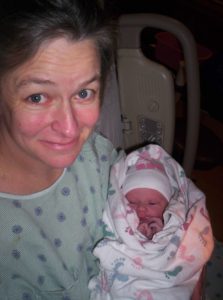“You were going clink clink clink, and I was going push push push!”
That’s how I laughingly describe New Year’s Eve 2006, and it is true! And it is the very tip of the ice berg — because she was full term.
Our first child stayed behind in the Neonatal Intensive Care Unit (NICU) for three months. I bow down to NICU nurses whenever and wherever I meet them. “Thing One” is 17 and accepts these encouters with lowered eyes, a smile, and a dip of his head. Our second child stayed behind in the hospital until she was cremated. Stories for another time.
When “Thing Two” formed from a glimmer in our eyes, we checked off her milestones before she was even born: phew, first trimester. Ug, the usual contractions at 20 weeks, but interventions in advance and then at their onset kept us in the game. We passed the 22-week mark where our second child had to be born. Then we passed the 24-week mark where our first child had to be induced. I failed the glucose test at 28 weeks, so we worked on to the end with gestational diabetes. She had weekly in-utero sonograms on a particular heart valve that may be affected by contraction blockers. I had multiple daily at-home blood glucose tests and weekly in-office stress tests.
The braid of hope, fear, and joy was so tight, we could barely tell one feeling from another.

Mother and baby.
That last month was rough, and I bounced down the stairs at work, encouraging her to come along already. After those first two births, I naturally thought she’d be safer in the hospital than in my belly. We made a date to be induced, and 6 hours before our appointment she started her journey. Nobody told her what to do.
Our pediatrician knew exactly how to doctor for us: reassuring us when he was absolutely positive; ready to answer all the questions that we’d learned to worry about; printing out the latest medical investigations on issues that mattered; keeping an eye on when vaccines were reformulated so we could wait and see how the new recipe worked; lending a careful ear to a heart murmur and speaking to educate us while watching extremely closely. We were high strung parents. We are. Dr. Kovel was like a family member.
None of this is what most consider “family history.” But it is and it’s real. The histories of children, birthing, special needs kids, and medical mothers should be part of our national history and part of world history — especialy because it is intertwined with medical, social, and public institutions. And rarely looks like a Normal Rockwell painting.
There currently is no “place” for atypical, special needs histories. They do not show up in census or other public records — unlike socioeconomics, family structures, racial striations, and work histories.
But I have made a place, and I invite you to get on my mailing list to be among the first to receive three things:
- a free tool for starting your atypical, medical, neurodiverse kid’s history,
- a few more steps to take to start building a history of your warrior child, and
- an opportunity to go further with that project in a group program that I’m preparing to re-launch.
Our kids’ intricate histories of diagnoses, effects, and outcomes — intricate histories that involve families, governemental programs, the medical arena and sometimes charitable institutions — must be told family by family. The evidence is yours to share. My one-page guide on what goes in a family archive is available: sign up now.
Today, “Thing 2” turns 14, and she’s splendid, and difficult, and all the things that teenagers are. We love you, darling girl.


 I spent 18 years as “archivist and senior research scholar” at an academic science library, actively trying to add women to the historical record and looking for the women who were already included almost accidentally. I have degrees in women’s history and cultural theory — the latter means that I see the cultural value of everyday practices such as food, clothing, hobbies, and domestic arrangements. Non-famous people matter.
I spent 18 years as “archivist and senior research scholar” at an academic science library, actively trying to add women to the historical record and looking for the women who were already included almost accidentally. I have degrees in women’s history and cultural theory — the latter means that I see the cultural value of everyday practices such as food, clothing, hobbies, and domestic arrangements. Non-famous people matter.